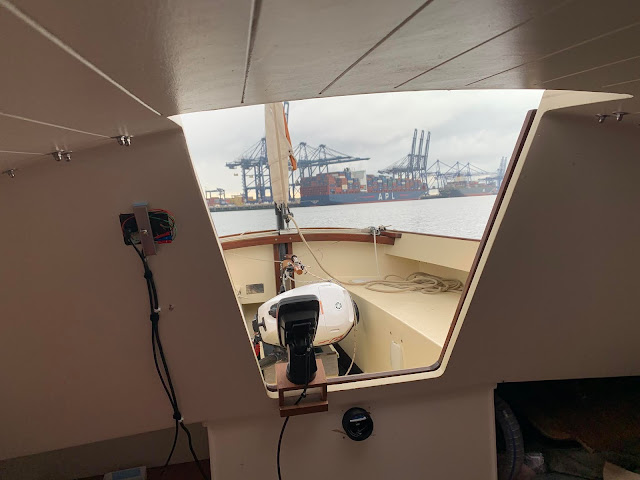
This short cruise was characterised by awkward weather - the breeze never really settled. Every cloud made its introduction with a smack around the face, and gracefully departed with a lash in its tail. Winds were never completely overpowering, but one could never really relax, always having to second-guess where the next gust was coming from.
Saturday, August 1st - launch at Titchmarsh Marina, sail to the River Stour
The slipway at Titchmarsh Marina
Trialling a new place for the ensign
I sailed from the Walton Backwaters to Harwich, and anchored opposite the container ship terminals, mainly to sort out things on the boat. The ensign, previously installed on a now snapped post poking out from the stern transom, has found a new home at the top of the mizzen. It works well enough except that it gets twisted around its staff when the mizzen is furled/unfurled. I can just about reach it with a pole but I can't see this being a permanent solution. I'm beginning to see more sense in the stern frame used on BC20 No1.
Drascombe coaster Dewineaeth, shaking out a reef in Harwich Harbour
Later in the day, I enjoyed a beat up the Stour, particularly catching up and overtaking a Cornish Shrimper on a similar course. Daisy III isn't necessarily quick, but she points well.
Of an evening, a still disorganised cabin, but some welcome victualling.
I like to cook out in the cockpit.
Tuesday 2nd August - Stour, a bit of Orwell and then Hamford Water
There wasn't really a plan for this cruise, just seeking opportunities to sail in familiar waters, becoming better used to the new boat and its various sail combinations.
Today, having dragged anchor overnight in conditions which refused to settle, I set off with double reefed main - which, as a single sail combination oddly seems to work better than with a single reef. I soon added the jib, and subsequently the mizzen.
Peaceful anchorage in Hamford Water
Monday 3rd August
Again, with no particular plan, I set off for Harwich Harbour and decided to sail up and down the Stour again for no reason other than to continue stretching the sea legs of this boat. The whole day was spent in motion and under sail - various combinations of sail. When I needed to add or remove a reef/sail, to make coffee/lunch, I simply hove to and the boat does this just as well as Daisy II did. The outboard wasn't troubled once.
As the day proceeded, clouds gathered and I was caught in some inevitable bad weather.
Storm clouds over Harwich
I did a bit of to-ing and fro-ing around the Holbrook Bay area, waiting for various storms to pass, before heading back down towards Harwich, aiming for an anchorage just off Pin Mill. Inevitably, another storm lashed me on entering the Orwell.
Storm clouds over Shotley
Peace returned for the evening - a lovely anchorage in the lee of the woods just east of Pin Mill.
30.4nm
Tuesday 4th August - return to Titchmarsh, recovery and homeThe other bit of wildlife witnessed today was a seal which had climbed aboard a tender, attached to its mother ship. I imagine the skipper and crew had an interesting time trying to remove the seal from its perch. In the meantime, this post is often frequented by cormorants drying their plumage.
Initially there as no wind today, but as I reached Harwich Harbour, an increasing SE breeze set in. I had a pleasant beat across Harwich Harbour against the flood, but conditions out in Dovercourt Bay were too choppy given my need to be back at Titchmarsh by noon. So, I furled sails and motored back to the slipway.
12.6nm
Overall, a really pleasant cruise
82.3nm
































































